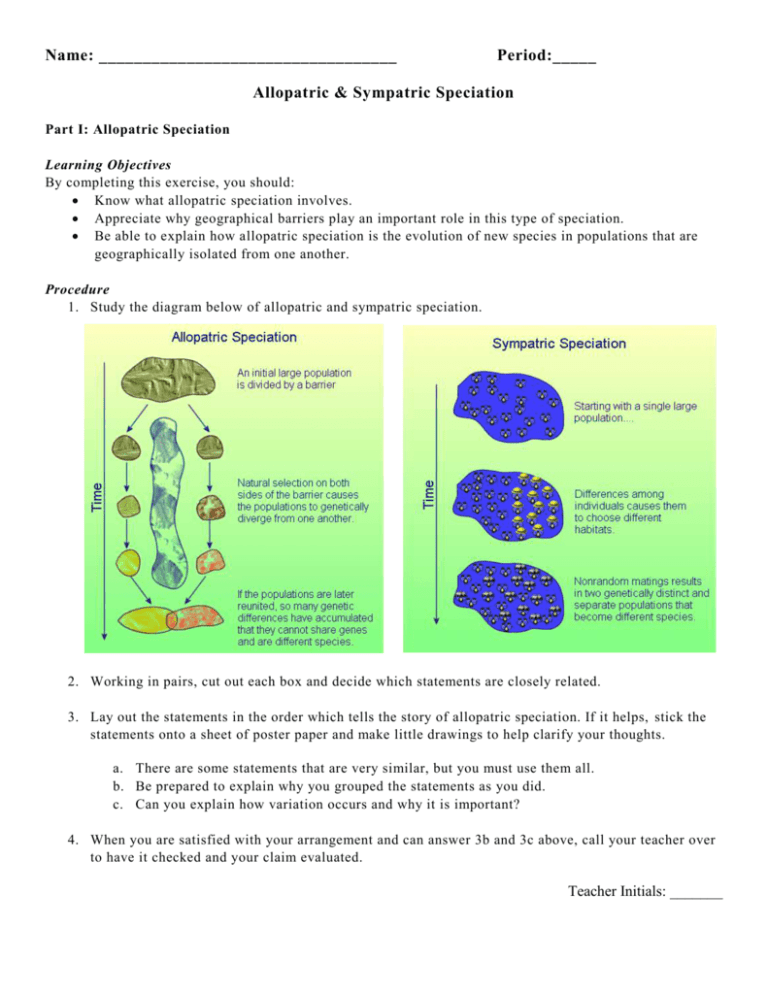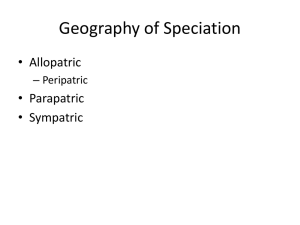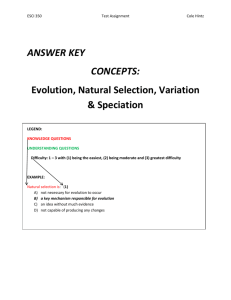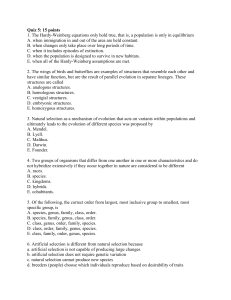Allopatric & Sympatric Speciation Worksheet
advertisement

Name: __________________________________ Period:_____ Allopatric & Sympatric Speciation Part I: Allopatric Speciation Learning Objectives By completing this exercise, you should: Know what allopatric speciation involves. Appreciate why geographical barriers play an important role in this type of speciation. Be able to explain how allopatric speciation is the evolution of new species in populations that are geographically isolated from one another. Procedure 1. Study the diagram below of allopatric and sympatric speciation. 2. Working in pairs, cut out each box and decide which statements are closely related. 3. Lay out the statements in the order which tells the story of allopatric speciation. If it helps, stick the statements onto a sheet of poster paper and make little drawings to help clarify your thoughts. a. There are some statements that are very similar, but you must use them all. b. Be prepared to explain why you grouped the statements as you did. c. Can you explain how variation occurs and why it is important? 4. When you are satisfied with your arrangement and can answer 3b and 3c above, call your teacher over to have it checked and your claim evaluated. Teacher Initials: _______ Part II: Sympatric Speciation Learning Objectives By completing this exercise, you should: Know the definition of sympatric speciation and by carrying out the research activity be able to give at least two examples of this type of evolution. Know that there are likely to be behavioural or ecological barriers in place to prevent gene exchange within a given area. o Behavioural barriers, such as breeding patterns or rituals, and o Ecological barriers, such as food availability, may operate in sympatric speciation. Be able to explain how sympatric speciation is the evolution of new species in populations that live in the same geographic area. Procedure Sympatric speciation is where new species evolve from a single species whilst inhabiting the same geographic region. The areas may overlap or be within the same boundary. The above definition raises the question of how speciation can occur within a population of interbreeding individuals. 1. Find out what sort of ecological and behavioural barriers lead to speciation within the same geographical area. Clearly explain what the selection pressures are and how this affects the phenotype of the emerging new species. a. The medium ground finch, cichlid fish and apple maggot flies of North America would make a good starting point (ex. type ‘ground finch and sympatric speciation’ into your search engine). b. Present your findings in a written report of no more than one page. Labelled diagrams with accompanying explanations are acceptable. Allopatric Speciation Statements Species generally give rise to fertile offspring. Isolation of a group of individuals due to mountain ranges, oceans or migration. Best adapted survive (survival of the fittest). Over time and many generations different characteristics begin to emerge. Starting off with one population, a common gene pool. Species are populations within which genes are free to mix by interbreeding. Less wellNew or adapted favourable organisms fail alleles are to pass on their passed onto the alleles to the next next generation. generation. Environmental selection pressures are different for each group. Genetic differences, due to mutations in the separated populations, begin to accumulate. Individuals within a population may not be able to compete as well as others. The original environment may be very different from the isolated area. Geographical barriers prevent interbreeding of populations. Healthiest or best individuals will be the most likely to breed. New phenotypes gradually appear in the population. Genetic drift (random mutations/ differences) occurs independently. Healthiest or best individuals will be the most likely to breed. Individuals within a Different Mutations give population may mutations arise rise to different become better in different phenotypes. at exploiting populations. their environment. Mutations occurring in each population will be different. Usually a good correlation with the phenotype (underlying new alleles) and the environment. Members of Evolution the different Often isolated occurs and new populations may become so populations are biological very small. distinct that species are formed. they can no longer breed.








